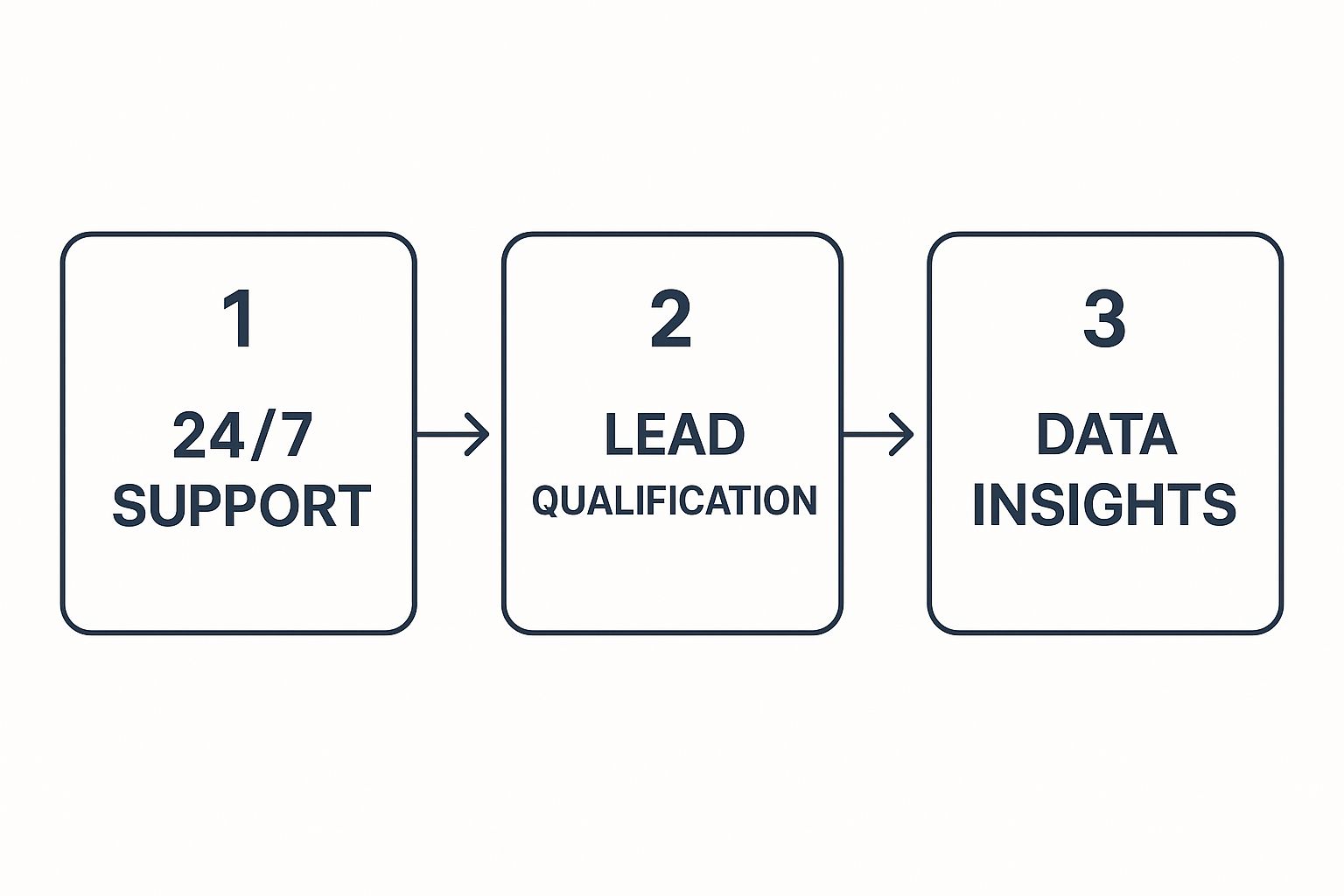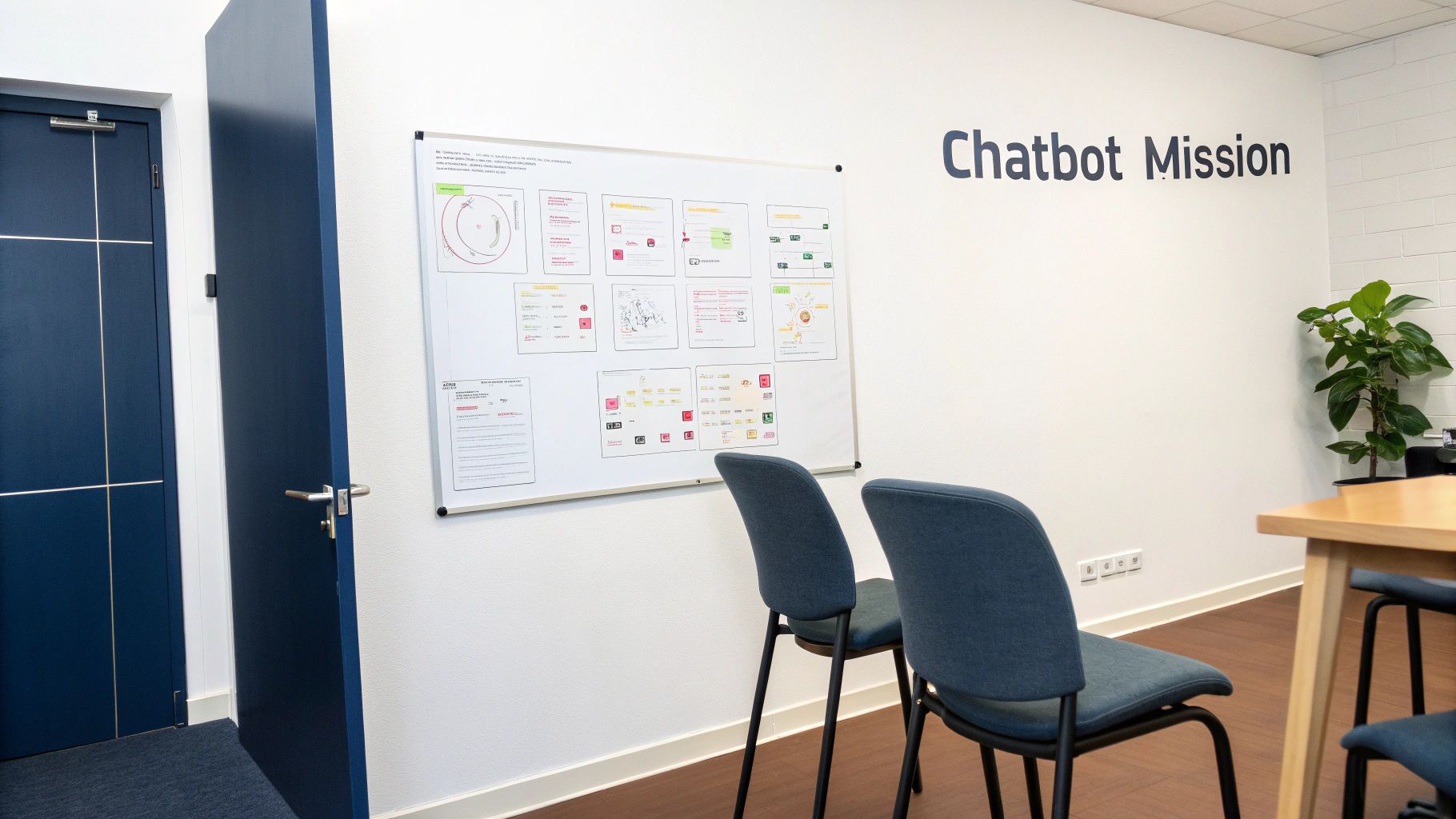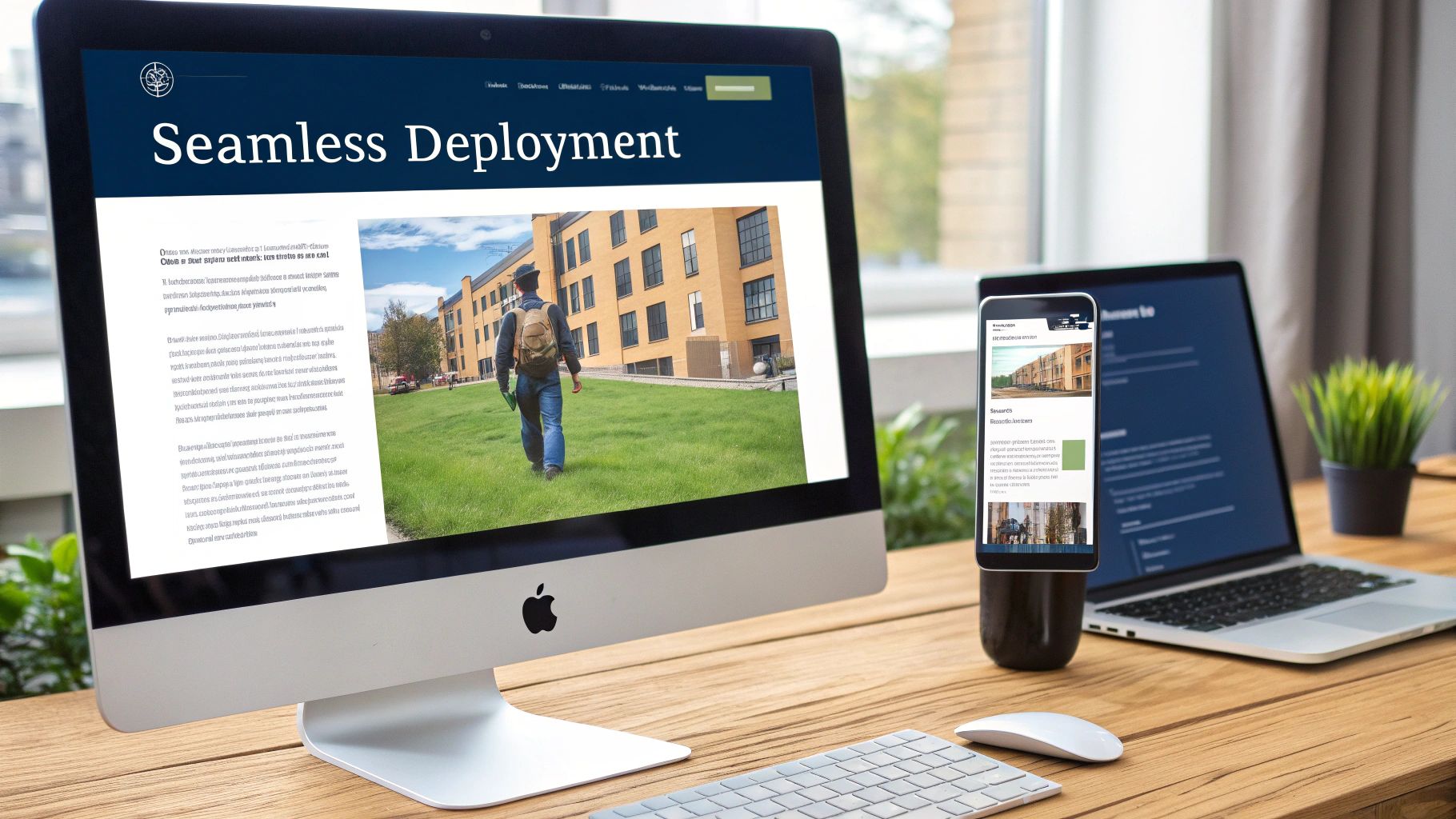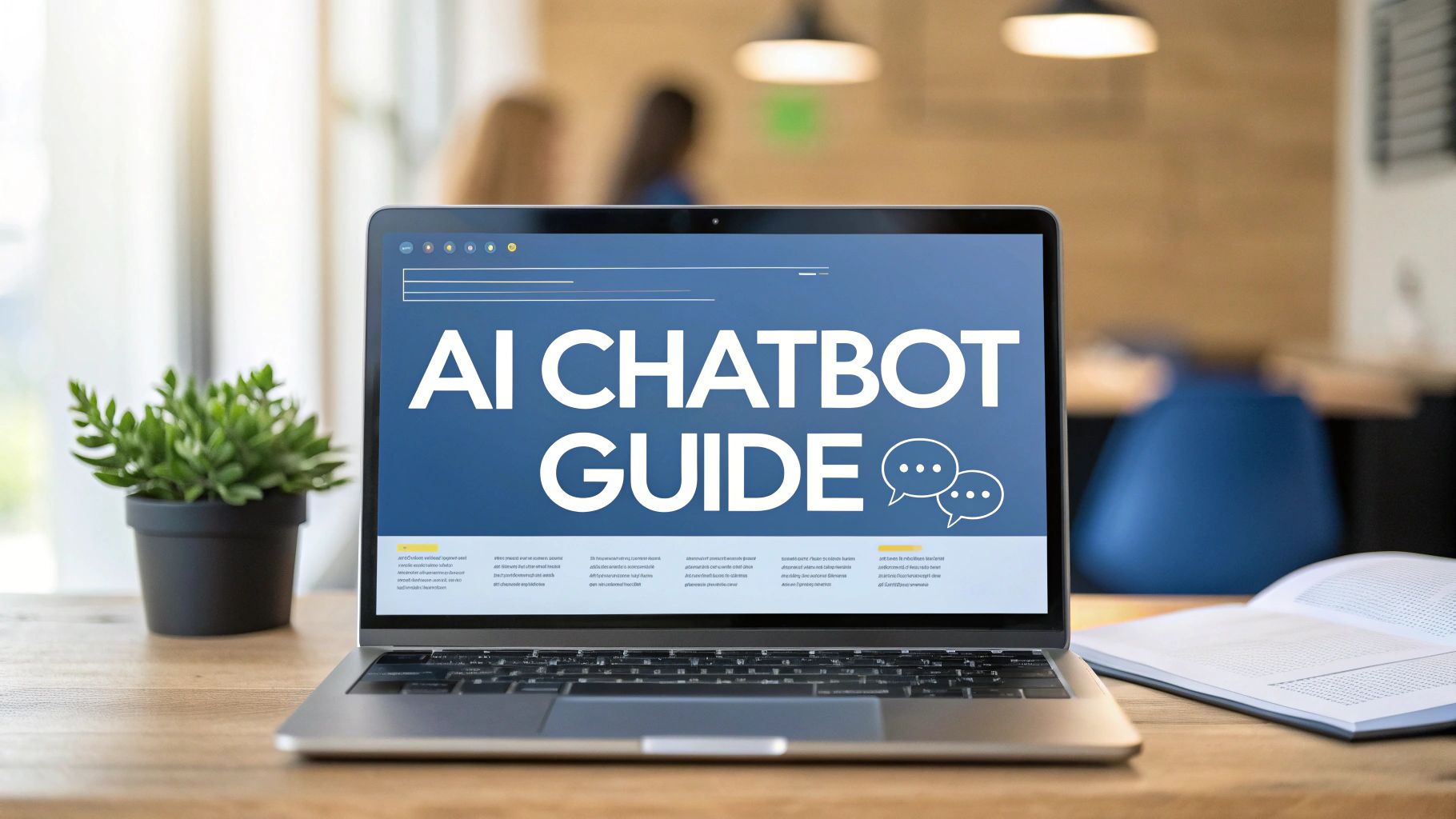Building an AI chatbot isn't just a tech upgrade; it's a game-changing business move. It puts your customer support, lead qualification, and data capture on autopilot, running 24/7. With a modern no-code platform like ChatbotGen, you can get a powerful, fully functional bot live in minutes, not months. This isn't just for the big players anymore.
Why Building an AI Chatbot Is a Strategic Move
Before we get into the nuts and bolts, let's talk about the why. This isn't about adding a flashy new widget to your site. It's about fundamentally changing how you connect with customers, qualify leads, and gather incredible business intelligence along the way.
Think of a well-built chatbot as your most reliable employee. It's always on, ready to help users at any time of day or night. That kind of instant availability is exactly what modern customers expect. Instead of making someone fill out a form and wait for an email, a chatbot can answer questions, book a demo, or qualify their interest on the spot. That's how you shrink the sales cycle.
Transforming Operations and Gathering Insights
Beyond just being helpful, chatbots are amazing data-gathering tools. Every single conversation is a direct window into your customers' heads. You get to see their most common questions, biggest frustrations, and what they really need from you.
This feedback is pure gold. It's raw, unfiltered, and perfect for refining your products, services, and even your marketing copy. You can sift through chat logs to spot trends, find gaps in your help articles, and learn the exact language your customers use. This creates a powerful feedback loop: the bot gets smarter, and your business gets more in tune with its audience.
The flow is simple but powerful: it starts with support, moves into lead generation, and results in data you can actually use.
This infographic lays out the typical value a business chatbot delivers.

As you can see, it all starts with providing support. From there, it's a natural step to identifying potential leads and, finally, collecting rich data that shapes your entire business strategy.
Capitalizing on Explosive Market Growth
The timing for this couldn't be better. The global AI chatbot market has absolutely exploded, rocketing from $2.47 billion in 2021 to a massive $15.57 billion in 2024. This isn't just a trend; it's a widespread shift as businesses everywhere realize how effective these automated tools are.
And it's not slowing down. Projections show the market is on track to hit an incredible $46.64 billion by 2029. That tells you one thing: chatbots are becoming a standard, essential business tool.
This also ties into the broader world of AI-driven solutions. For example, understanding how different platforms use AI agents for specialized tasks like SEO helps put your chatbot project into a larger strategic context. By automating these key interactions, you free up your team to focus on the high-impact work that truly needs a human touch.
Defining Your Chatbot's Mission and Scope

Before you even think about uploading a single document or tweaking a welcome message, we need to talk about the most important step: giving your chatbot a job. A bot without a clear mission is just a fun piece of tech. But a bot with a focused purpose? That's a powerful business asset.
The question you need to ask yourself is, "What problem am I really trying to solve?" This initial planning phase is your best defense against scope creep and the key to building a bot that delivers real value.
A classic mistake I see all the time is trying to build a bot that can "do everything." It's a recipe for a mediocre experience. Instead, get specific. If your support team is drowning in the same five questions every day, that's a perfect mission for your chatbot. Start there.
Pinpointing Your Core Purpose
The best chatbots are specialists. They do one or two things incredibly well, and those things align directly with a business goal. Nailing down this core function early on gives you a roadmap for everything that follows—from the data you use for training to the way you design its conversations.
Not sure where to start? Here are a few high-value missions we see a lot:
- Automating Customer Support: The bot’s main job is to instantly answer common questions like, “Where’s my order?” or “What are your hours?” This frees up your human agents for the tricky stuff.
- Generating and Qualifying Leads: Think of the bot as a proactive sales assistant. It can engage visitors, ask a few qualifying questions, and even get a demo booked on your sales team's calendar.
- Guiding User Journeys: For an e-commerce site, a bot can be a personal shopper, helping customers find the perfect product based on what they need.
Once you’ve picked a primary goal, every other decision should support it. If the bot is all about lead gen, then its conversations need to be laser-focused on gathering contact details and scheduling meetings. You can see a deep dive on this in our guide on using a chatbot for lead generation. This focus is everything.
Crafting a Personality and Mapping Conversations
With a clear mission in hand, you can start thinking about how the chatbot should sound. Its personality isn’t just fluff; it should be a direct extension of your brand’s voice. Are you casual and fun, or more buttoned-up and professional?
Key Takeaway: A chatbot's personality isn't just about being friendly. It's about creating a consistent brand experience that builds trust and makes people want to engage.
From there, map out the ideal conversation from your user’s perspective. What’s the first thing they’re likely to ask? What information will the bot need to give them a truly helpful answer? Sketching out these dialogue paths helps you anticipate what people need and design interactions that just feel intuitive.
Setting Meaningful KPIs to Measure Success
Finally, a well-defined mission makes it easy to set clear Key Performance Indicators (KPIs). Without metrics, you’re just guessing. The right KPIs tie directly back to the bot’s core job.
Here’s a simple framework to help connect your business goals to metrics that actually matter.
Chatbot Use Case and Goal Setting Framework
This framework helps you define your chatbot's primary function and establish clear, measurable success metrics for different business goals.
| Business Goal | Chatbot Use Case | Primary KPI | Example Metric |
|---|---|---|---|
| Reduce Support Costs | Answering FAQs | Containment Rate | 80% of chats resolved without human handoff |
| Increase Sales Pipeline | Booking Demos | Conversion Rate | 15% of bot chats result in a booked demo |
| Improve User Experience | Onboarding New Users | Task Completion Rate | 90% of users successfully complete the onboarding flow |
| Enhance Customer Loyalty | Post-Purchase Support | Satisfaction Score (CSAT) | Average user rating of 4.5/5 after interaction |
Start tracking these numbers from day one. This data will tell you exactly what’s working and where you need to make adjustments, ensuring your chatbot is more than just a cool feature—it's an engine for growth.
Choosing the Right Technology Stack

The platform you choose for your AI chatbot is one of the most important calls you'll make. It sets the stage for your bot's capabilities, how fast you can get it live, and whether it can grow with your business. Thankfully, you've got options, which really boil down to two main camps: easy-to-use no-code platforms and more hands-on custom development.
For most businesses, especially small and medium-sized ones, a no-code platform like ChatbotGen is the way to go. These tools are built for speed and simplicity, letting you create a smart AI assistant without touching a single line of code. You can have a bot up and running on your site in a few hours, not weeks.
The biggest win here is just how easy it is to get started. If you can upload a PDF or paste a link to your FAQ page, you're good to go. This puts the power to build a chatbot directly into the hands of the people who understand your customers best—your marketing, sales, and support teams.
No-Code Platforms: The Fast Track to Automation
The whole point of no-code is efficiency. Instead of getting tangled up in APIs and server settings, you get to focus on what actually matters: the quality of your bot's answers and the experience you give your users.
These platforms do all the heavy lifting behind the scenes. They tap into powerful AI models, manage all the data, and give you a simple dashboard to customize how your bot looks and acts.
This approach comes with some huge perks:
- Speed to Market: Go from a new idea to a working chatbot in a single afternoon.
- Lower Costs: You won't need to budget for expensive developers or an outside agency.
- Easy Maintenance: Keeping your bot's knowledge fresh is as simple as uploading a new file.
As you weigh your options, looking into no-code AI development platforms can offer some great perspective. The speed they offer is a real competitive edge, letting you tweak your bot in real-time as customer needs change.
Custom Development: The High-Control Route
At the other end of the spectrum, you have custom development. This means building a chatbot from scratch with programming languages and AI frameworks. It gives you total control and flexibility, which can be the right choice for massive companies with highly specific, complex needs that an off-the-shelf tool can't handle.
But all that control comes with a hefty price tag. Custom builds are slow, incredibly expensive, and require a dedicated team of skilled developers and AI experts to build and maintain. For common tasks like generating leads or answering support questions, the huge investment just doesn't make sense when you compare it to what modern no-code tools can do.
Expert Tip: Unless you have a unique need to integrate with old, proprietary systems or require a bot to handle very specialized, multi-step tasks, a no-code platform will almost always deliver 95% of the value for a tiny fraction of the time and cost.
Understanding the Generative AI Engine
No matter which path you take, the "brain" of your chatbot is a generative AI model. These are the large language models (LLMs) that have gotten so good at understanding and generating text that sounds completely human.
Pioneering models have shown what's possible. For instance, ChatGPT has held onto a massive market share of 74.9% as of May 2025. Its strength comes from its powerful core technology and deep integrations that help personalize the user experience.
No-code platforms like ChatbotGen plug you directly into these powerful models, giving you access to world-class AI without the headache. You get all the power of the technology without having to manage any of the complex infrastructure yourself. By picking the right tool, you’re not just building a bot; you're connecting to the very latest in AI innovation.
To dive deeper, check out our guide on how to choose an AI chatbot creator that’s a perfect fit for your business.
Bringing Your AI Chatbot to Life
With your mission defined and technology chosen, we get to the fun part—turning that strategy into a real, working AI assistant. This is where you actually breathe life into your bot, giving it the knowledge it needs to be genuinely helpful.
Forget about complex coding. Creating an AI chatbot today is much more about being a great teacher than a programmer.
Using a no-code platform like ChatbotGen, this stage is incredibly straightforward. The whole idea is to feed the AI high-quality information it can use to answer questions accurately and naturally. You're not writing complex rules; you're just providing good source material.
Your goal is to build a "second brain" for your business—an AI that holds your collective knowledge, experience, and even a bit of your brand’s personality. The better the information you provide upfront, the smarter and more capable your chatbot will be from day one.
Feeding Your Chatbot Knowledge
The foundation of any great chatbot is its knowledge base. Think of it as the library your bot will pull from every time a user asks a question. Modern AI is fantastic at understanding context, but it can only work with the information you give it.
Your first move is to gather all the relevant documents and content that hold the answers your customers are looking for.
Here are the most effective sources to start with:
- Website Content: Your existing website is a goldmine. FAQ pages, service descriptions, and blog posts are packed with useful information. Simply providing the URLs lets the bot crawl and learn from your public content.
- Internal Documents: Have product manuals, support guides, or internal knowledge base articles? Upload them as PDFs. This is perfect for giving the bot detailed, structured information.
- Plain Text: Need to add a quick update? You can type or paste text directly. This is great for temporary changes, like new promotion details or updated business hours.
The process is designed for simplicity. You upload your files, and the platform handles the heavy lifting, creating a searchable database that allows the AI to find the most relevant information for any query in a flash.
Designing Intuitive Conversational Flows
While today's AI can handle a huge range of free-form questions, sometimes you need to guide the user toward a specific outcome. This is where designing simple conversational flows comes in, especially for things like lead generation or booking appointments.
Instead of a rigid, old-school decision tree, think of these as gentle nudges. For example, if a user asks about pricing, the bot can provide the info and then proactively ask, "Would you like to see a demo to learn more?"
Pro Tip: Your conversational flows shouldn't feel like an interrogation. Keep them short, sweet, and focused on a single goal. The best flows mix proactive guidance with the freedom for the user to ask anything they want at any time.
A great way to map this out is to think about the key actions you want users to take. For a real estate agency, a flow might capture a lead's contact information. For an e-commerce store, it might guide a user to the right product category.
The Iterative Process of Training and Refinement
Building an AI chatbot isn't a one-and-done project. The real magic happens through an ongoing cycle of training, testing, and tweaking. Your initial build is just the starting point; the bot gets smarter and smarter as it interacts with real users.
This feedback loop is crucial. Most platforms, including ChatbotGen, give you an analytics dashboard where you can see the actual questions people are asking. This is your roadmap for improvement.
Look for a few key things in your chat logs:
- Unanswered Questions: Are there questions your bot just couldn't answer? That’s a clear sign you need to add new information to its knowledge base.
- Incorrect Answers: If the bot gives a wrong answer, it often means the source material was unclear or contradictory. You can go back and refine your documents to be more precise.
- User Frustration: See conversations where users rephrase their question multiple times? This can point to a conversational flow that needs improving or a topic that needs more context.
This process of continuous improvement is what separates a decent chatbot from a truly exceptional one. By regularly reviewing user interactions and updating your knowledge base, you teach the bot to handle more queries with confidence. Our detailed guide on how to build a chatbot offers more advanced strategies for this refinement phase. This approach ensures your bot evolves right alongside your business, becoming an increasingly valuable asset over time.
Deploying Your Chatbot into the Wild

You've done the hard work of training and fine-tuning your AI chatbot. Now for the exciting part—unleashing it. This is where your bot stops being a behind-the-scenes project and becomes a living, breathing part of your customer experience.
But a great launch is more than just flipping a switch. You need a smart rollout strategy to make sure your audience actually finds and uses the chatbot. Getting this final step right is what turns all your effort into real, measurable results.
Embedding Your Chatbot on Your Website
Your website is the natural home for your new assistant. It’s the first place customers go when they have questions, so putting a chatbot there gives them an instant way to get help or find information.
With a platform like ChatbotGen, this couldn't be easier. You’ll get a small snippet of code to copy and paste into your site's HTML. No developer skills needed—if you can update a page on your website, you can add the chatbot.
Placement is key. The best practice for most businesses is to have the chat widget pop up in the bottom-right corner of every page. People are used to seeing it there, and it ensures help is always just a click away, no matter where a visitor navigates.
Expanding Your Reach to Messaging Apps
While your website is a fantastic starting point, you should always aim to meet your customers where they already are. Deploying your chatbot on popular messaging apps like WhatsApp or Telegram opens up a direct and incredibly convenient channel for communication.
When you integrate with these platforms, your chatbot becomes a contact that users can message just like a friend. It's the perfect setup for sending order updates, answering quick questions on the fly, and adding a much more personal touch to your interactions.
The data backs this up. Over 987 million people are already using AI chatbots, and that number skyrockets when you factor in website interactions. This massive adoption shows just how critical these tools are for improving customer service everywhere, from retail to real estate. You can dig into more of this data in this detailed report on chatbot statistics.
Key Takeaway: A multi-channel strategy isn't just a nice-to-have anymore. By making your chatbot available on your site and key messaging apps, you create a consistent, accessible experience for everyone.
Running a Beta Test Before the Big Launch
Before you roll out the red carpet, it’s a smart move to run a small-scale beta test. This is your chance to catch any awkward phrasing, knowledge gaps, or weird quirks in a safe, controlled environment.
Here’s a simple way to run an effective beta test:
- Pick a small test group: Ask a handful of loyal customers or internal team members (who weren't part of the build) to give it a spin.
- Give them a mission: Don't just say "try the bot." Ask them to complete a specific task, like finding your return policy or asking about a product's warranty.
- Collect honest feedback: Set up a simple form or just have a conversation. Was the bot helpful? Were any answers confusing? Did it get stumped by an easy question?
This kind of pre-launch feedback is pure gold. It helps you make those final, crucial tweaks that elevate the user experience from good to great. Think of it as a dress rehearsal—it ensures a flawless opening night when you finally go live.
Common Questions About Creating a Chatbot
As you get closer to actually building your AI chatbot, a few questions always seem to come up. It's totally normal. Moving from an idea on a whiteboard to a live assistant means thinking about new things, so it helps to get clear answers right from the start.
Think of this as your quick-start FAQ. We'll cut through the noise and talk about what really matters: budget, timelines, and the skills you actually need (or, more importantly, don't need). By the end, you'll have a much clearer picture of the road ahead.
How Much Does It Cost to Create an AI Chatbot?
This is the big one, and the answer really depends on the path you take. The investment can range from a small monthly fee to a serious capital expense. It breaks down into three main buckets.
- No-Code Platforms: This is, without a doubt, the most popular and budget-friendly route today. Using a tool like ChatbotGen usually means a simple monthly subscription, often costing less than a team lunch. It strikes the perfect balance between power and affordability for most businesses.
- Agency Development: If you need something highly specialized, you could hire an agency to build a custom chatbot. Be prepared for a significant jump in cost, though. Projects typically start around $5,000 and can easily exceed $50,000, all depending on the bot's complexity and integrations.
- In-House Team: This is the most expensive option by a long shot. You're not just paying for a one-time build; you're taking on full-time salaries for developers, AI specialists, and project managers. It’s a massive, long-term financial commitment.
For the vast majority of companies, a no-code solution is the smartest entry point. You get powerful, immediate results without the sticker shock of custom development.
How Long Does It Take to Build a Chatbot?
Your timeline is directly tied to the tech you choose. The speed at which you can go from concept to a live, helpful bot is probably the biggest difference between the options.
With a user-friendly, no-code platform, speed is the whole point. You can realistically have a smart, functional chatbot on your website in just a few hours. A couple of days at most. The interfaces are designed to get you building your bot's brain, not fighting with code.
A custom-built solution is a much longer journey. Even a relatively simple custom bot will likely take 4 to 6 weeks of development, testing, and revisions. For a true enterprise-level assistant with deep system integrations, you could easily be looking at 6 months or more before it's ready for prime time.
What Are the Key Metrics for Chatbot Success?
Success isn't about just having the tech; it's about what the tech does for your business. To know if your chatbot is actually working, you have to track the right Key Performance Indicators (KPIs).
Here are the core metrics you should be watching:
- Resolution Rate: What percentage of questions does the chatbot solve on its own, without a human needing to jump in? This is your main measure of effectiveness.
- User Satisfaction (CSAT): Are people happy with the experience? A simple "rate this conversation" survey at the end gives you instant, direct feedback.
- Containment Rate: How many conversations start and finish entirely within the chatbot? A high containment rate means your bot is successfully handling what it was built for.
- Task Completion Rate: If your bot has a specific job—like booking a demo or finding a product—this tracks how many users actually complete that action.
These numbers give you a clear, data-driven view of your chatbot's performance and, ultimately, its return on investment.
Do I Need Coding Skills to Build a Chatbot?
Not anymore. This is probably the most important shift in this space. The old idea that you needed a developer on staff to build a useful bot is completely out of date.
The new generation of powerful no-code platforms has changed the game. Tools like ChatbotGen use intuitive, visual builders that let anyone create a highly sophisticated AI assistant without writing a single line of code.
Key Insight: The modern way to build a chatbot is to be a good teacher, not a programmer. Your job is to give the AI good information by uploading documents or pointing it to your website. The platform handles all the heavy lifting behind the scenes.
This shift puts the power to build and manage AI assistants right where it belongs: with the marketers, support leads, and business owners who know their customers best.
Ready to see how simple creating an AI chatbot can be? ChatbotGen is the no‑code platform designed to get your business automated in minutes. Start your free 7-day trial and launch your own AI assistant today. Visit https://chatbotgen.com to learn more.
